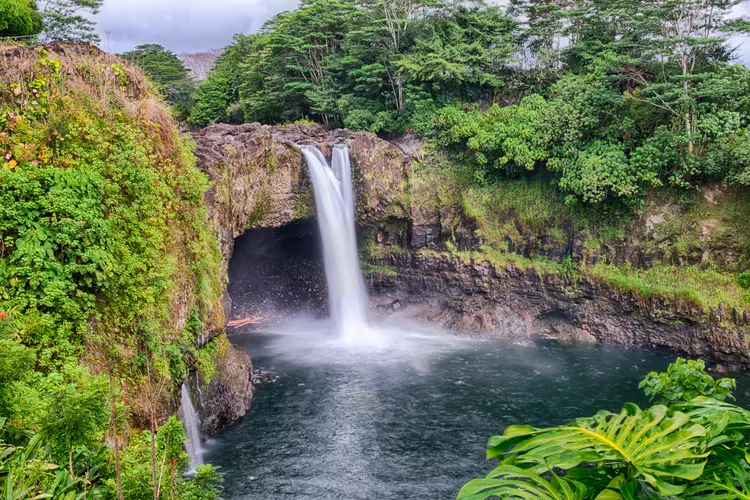1. Overview
Hilo features some of the best attractions in Hawaii. This article explores a few highlights that make Hilo and the broader region on Hawaii’s Big Island so special.
2. Hilo Town
Hilo’s charming and beautifully restored clapboard and stucco buildings near the bayfront are home to an array of flower and antique shops, local designer boutiques, diverse ethnic restaurants, and delightful hole-in-the-wall eateries serving traditional Hawaiian cuisine. A vibrant farmers market showcases exotic fruits, Hawaiian coffees, fresh vegetables, and local crafts at great prices, as well as unique offerings like massage services.
3. Museums
- The East Hawaii Cultural Center features intriguing exhibits by local artists.
- The Pacific Tsunami Museum narrates the dramatic events of the 1946 and 1960 tsunamis that struck Hilo and Hawaii.
- The Lyman Museum and Mission House displays Hawaiian artifacts and natural history collections in a historic building from 1839, originally constructed by American Christian missionaries.

4. Imiloa Astronomy Center
The Imiloa Astronomy Center presents stunning planetarium shows and informative exhibits that illuminate the significance of the stars to the early Polynesian voyagers who first arrived on these islands.
5. Mokupapapa Discovery Center
The interactive displays at the Mokupapapa Discovery Center provide insight into the Papahanaumokuakea Marine National Monument, located in the remote Northwest Hawaiian Islands.
This Monument is Hawaii’s second UNESCO World Heritage Site, alongside Hawaii Volcanoes National Park, which is situated just north of Hilo town.
Hilo offers an authentic community experience, where friendly long-time residents trace their ancestry back to sugar plantation workers who were largely immigrants from Japan and the Philippines.

6. Gateway to East Hawaii
Hilo serves as the gateway to East Hawaii, an often-overlooked adventurer’s paradise stretching from the remote Ka Lae peninsula—recognized as the southernmost point in the U.S. and a National Historic Landmark—up to Hawaii Volcanoes National Park, home to the ever-active Kilauea volcano. This dynamic region showcases breathtaking jungles that cascade down the slopes to the Puna coastline, dotted with lava-heated ponds and picturesque tidepools.
Here, visitors can also explore the Pana’ewa Rainforest Zoo, the only rainforest zoo in the U.S., which is free of charge, along with Volcano Winery, the island’s sole winery.
This area extends to the summit of Mauna Kea, the tallest mountain in the world when measured from its base beneath the sea, and the scenic Hamakua Coast, where mesmerizing waterfalls, lush botanical gardens, and historic sugar plantation towns meet the untamed beauty of Waipio Valley.
Spirited travelers can select from a myriad of adventures or craft their own experiences, whether hiking, swimming, ziplining, horseback riding, or dining.
A recommended local company to explore is KapohoKine Adventures, based in Hilo, which offers an array of exciting tours.
While a brief two or three-day visit can showcase the highlights of East Hawaii Island, a week may offer even more opportunities for adventure and enjoyment.

7. Lodging
Instead of grand five-star resorts, the Hilo area presents a variety of inns, cozy bed & breakfast cottages, and family-friendly hotels, along with comfortable cabins and campgrounds. The authenticity of Hilo town and its surrounding districts greatly enhances the area’s appeal.
Two of the most popular accommodations include the Hilo Hawaiian Hotel and the Hilo Naniloa Hotel, conveniently located on Banyan Drive, next to Kapiolani Park, and within walking distance to downtown.

8. Fast Facts
- Kilauea is the world’s most active volcano, with continuous flow since January 3, 1983.
- Thurston Lava Tube (Nahuku) is one of the world’s most accessible lava tubes, located at Hawaii Volcanoes National Park.
- Hawaii’s human history commenced at Ka Lae in the Kau District, where Marquesans made landfall between 500 and 800 A.D.
- King Kamehameha the Great launched 800 canoes from Hilo Bay, setting sail in his quest to conquer Kauai.
- Hilo hosts the Merrie Monarch Festival, the world’s largest and most renowned hula competition, each year the week following Easter Sunday.
- East Hawaii is responsible for producing 95 percent of the state’s papayas and 65 percent of the world’s macadamia nuts.
- Averages of 130 inches of rain per year bless Hilo, resulting in stunning waterfalls, lush foliage, and abundant rainbows.

9. Beaches and Ocean Activities
While broad, manicured white sand beaches are absent in East Hawaii, locals do not seem to mind. Hilo town residents enjoy the tranquil coves and beach parks along Kalanianaole Avenue in Keaukaha for picnicking, snorkeling, and exploring tidepools.
Exploring farther around East Hawaii reveals hidden black sand beaches and secret snorkeling spots along the dramatic, lava-rock shorelines of the Hamakua Coast and Puna Coast.





